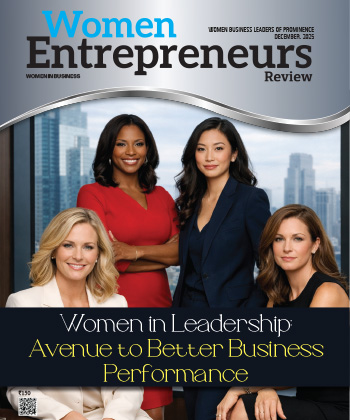
Women in Leadership: An Unstoppable Force Set to Define the 21st Century
By: Amrita Nawal, Associate Vice President, Bajaj Finserv Group
Amrita, a Senior Leadership Development Practitioner with 16 years of experience, excels in the BFSI, IT, Engineering, and Manufacturing sectors. She specializes in coaching, process facilitation, and dialogic processes, aiming to create high-performing workplaces where individuals find meaning and value.
In a recent conversation with Women Entrepreneurs Review Magazine, Amrita discusses how women leaders can balance traditional and innovative leadership approaches, subtly influence corporate culture to be more inclusive, and ensure programs are designed to recognize and nurture diverse talents and perspectives.
Age-old and established industries such as BFSI, Manufacturing, and ITES, see the prevalence of traditional leadership styles. How can women leaders strike a balance between traditional leadership approaches and introducing innovative, contemporary leadership practices?
To understand this question is it important to understand The Evolution of Leadership Styles 50,000 years ago – Tribal Leadership – Fear Based
As Hunter Gatherer society tribes were constantly moving from one place to other for food. This demanded Tribal Leadership as the responsibility of the Leaders were to provide security to the tribe. These leaders practiced Fear based Leadership as everyone in the tribe needed to obey the rules and punished brutally to inject Fear.
5,000 years ago – Agrarian Leadership – Rule Based
Human Civilization was just beginning to take shape and we were moving from Hunter Gatherer to a more organized Agrarian Society. We needed rule-based Leadership as the responsibility of the Leaders were to provide security and harmony so that different group could co-exist and thrive. These leaders practiced rule-based Leadership as everyone in the society needed an authority figure who would provide for food and shelter.
500 years ago – Industrial Revolution as a Landmark Development with Enlightenment came Heroic Leadership
This was an interesting shift as enlightenment, industrial revolution and other inventions led to reasoning and development of art, culture and expanded human mind and intellect. The period saw many famous leaders in different sphere and let to Heroic Leaders from Political to Science and Technology
50 years ago – In the information age, Leadership is now experienced in service of others. In this context, women leaders have this intuitive and cultural context based on years of role division, which is in service of family, society. This is an important milestone and Women Leaders have a very high chances of experiencing success in the leadership roles due to their service orientations, and deep cognitive empathy.
Women leaders are encouraged to raise their resilience and overcome traditional barriers and old mental models of ‘not confident enough’ or looking for ‘reassurance’ and trust their skills and raise their preparation to advance their careers. Having empathetic communication skills valuing the need of all stakeholders – women executives can add significant value in meeting senior leadership expectations. They can deliver great results by providing regular feedback, support the risky decisions by balancing thoughtful and reflective practice in a rapidly changing work ecosystem.
What are some of the subtle ways in which women leaders can influence and transform corporate culture to be more inclusive and supportive of diverse leadership styles?
Corporate culture today is experienced as high pressure with deliverables and client requirements to stay connected 24x7. This can lead to burn out and demand young talent to constantly deliver under tremendous pressure. Since women leaders have great sense of foresight and sensing skills, they can balance the customer expectations by creating and mentoring an empowered team where team members can take decisions and reduce the cycle of approvals to manage bureaucracy. Women leaders demonstrate great communication skills. With right amount of exposure and training they can nurture the team to handle complex expectations and support stakeholder management in a more natural way.
Competency-based skill development is vital for modern organizations. How can women leaders ensure that these programs are designed and implemented in a way that recognizes and nurtures diverse talents and perspectives?
Competency and skill-based development programs will be crucial for developing talent as per industry practices. Women leaders can ensure that the skill - development programs are mapped to the skills required by the specific functional domain. For example, in BFSI sector it is highly recommended that young talent are exposed to tech and AI side of learning which enables a more agile team contrary to a manufacturing sector company which may value project management skills to balance all the stakeholders and deliver time bound results.
How can women leaders balance assertiveness with empathy in their leadership styles? What impact does this balance have on team dynamics and performance?
Women in leadership can explore the entire practice of assertiveness. The style of communication of most of male leaders is often Goal Oriented with stating point of views in a directive manner Women leaders on the other hand by nature are wired to take into account diverse views and assimilate them with logic, emotions and intuition without hurting anyone’s feelings.
In a world where decisive, goal/target oriented and aggressive leadership styles are more practices and celebrated Women Leaders can change the entire leadership space by practicing Inclusive and Empathetic leadership styles which encourages collaboration, creativity which is directly responsible for building high performing sustainable, cross functional and cohesive teams.
Sustainability is becoming a critical focus for businesses globally. How can women in leadership positions advocate for and implement sustainable business practices while maintaining profitability and growth?
As per UN World Commission: “sustainable development is development that meets the needs of the present without compromising the ability of future generations to meet their own needs.”
Sustainability as a practice is gender agnostic. Women work mostly in large numbers and have mostly unrecognized participation in agriculture, fisheries, textile industries etc. Since most women are recognized as multidimensional and considered the first responders to their families, they have unique ideas and perspectives which can drive change at various levels.
Senior Women Leaders can leverage their presence and voices by exercise their influencing skills and network to create sense of urgency on these matter like water, environment, health, and education which are overlooked hence inspire to lead from the front. Senior women leaders must use their both formal and informal channels of communication and highlight this information to increase the participation of women from all sectors towards driving sustainability.
How do you envision the future of leadership development, particularly for women leaders? What emerging trends should organizations be aware of to stay ahead in nurturing female leadership talent?
The future of Leadership Development is highly promising. As organizations are now conscious of Gender Diversity and the benefits that a diverse leadership team plays there is a rising trend to hire or promote senior women executives to leadership roles.
Since women are better at sensing unarticulated customer expectations, managing all stakeholders by being adept at communication skills and flexible to accommodate diverse views with ease they are consistently preferred to lead large teams with high stakes.
Organizations should take effort to nurture the young women leaders by
- Fast Track/Special Projects - Offering fast track projects.
- Clear Career Roadmap – Technical to leverage STEM background and management roles.
- Flexibility - To sustain and accommodate changing life’s situation suitable flexibility in policies w.r.t. elderly care, adoption, maternity, and other flexibilities to support life’s stages will be one of the most helpful actions to respect diverse work groups.
- Handling Unconscious Bias - Becoming mindful of the Asian and especially Indian social construct and offer mindset sessions to handle unconscious bias at workplace which may silently become the reason to contribute towards a leaking talent pipeline.
- Leveraging talent from remote and other economically less exposed backgrounds - Exploring Tier 2/3/4 cities and encourage women from all social and diverse backgrounds to enter workplace by increasing their financial capacities will provide disproportionate advantage to the organizations.
Most Viewed
- 1 Women's Health Startup HerMD Closing Doors Amid Industry Challenges
- 2 5 Famous Women in Indian Armed Forces
- 3 Saudi Women No longer Require Male Permission for Clothing Choices, says Prince MbS
- 4 Kolkata Medtech Startup Innovodigm Raises Rs 5.5 Crore Seed Funding Led by IAN Group
- 5 Yamunanagar's Kashish Kalra Honoured after Securing 111th Rank in UPSC Civil Services Exam
- 6 Madurai Appoints Its First Woman Corporation Head
- 7 IAS Vijayalakshmi Bidari Appointed as the new Nagpur Divisional Commissioner
- 8 American Entrepreneur Lucy Guo Overtakes T Swift to become Youngest Female Billionaire
- 9 ICC Women's World Cup 2025 Trophy Showcased at Indore's Holkar Stadium
- 10 Aparna Saxena's Beauty Venture AntiNorm Launches in India
- 11 Vidya Nataraj Co-Founded BlueStone Jewellery & Lifestyle files IPO
- 12 5 Women Freedom Fighters of India
- 13 Dr. G Krishnapriya appointed as CEO for Trichy
- 14 M3M & Sirona Partner to Introduce Menstrual Hygiene Vending Machines in 15 Locations
- 15 Punjab Govt launches SHE Cohort 3.0 Supporting Tech-led Women Startups
- 16 Indian origin Lawyer, Sweena Pannu appointed as the US New Superior Court Judge
- 17 The Aurora Tech Award recognizes 4 Indian Women-led Startups
- 18 Kerala's Republic Day parade featured an all-female tableau
- 19 Manisha Kabbur Becomes Karnataka's First Woman International Karate Coach
- 20 Director K. S. Ravikumar's Daughter Maalica Ravikumar Launches Life Coaching Company 'Evergrowth Academy' for Women
- 21 Leezu's Raises Pre-Seed Funding to Accelerate Growth in Sexual Wellness Industry
- 22 Sattu: Super-easy summer drink for PCOS gut healing
- 23 Swathi Nelabhatla creates Sitha App, India's First Women-Exclusive Gig Platform
- 24 7 Timeless Female Kathak Dancers & their Iconic Legacies
- 25 Meet 7 Iconic Women Architects of Modern India & their Most Impactful Work
- 26 This Woman-led Insuretech Startup is Helping Bridge the Education Financing Gap in India
- 27 Women Leaders Share Lessons Learnt from India Women's WC Win
- 28 5 Enterprising Women Founders Powering Singapore's Tech & Innovation Landscape
- 29 4 Women. 4 Stories. One Vision for Smarter, Stronger Healthcare
- 30 Global Gender Gap Narrows to 68.8%, But Full Equality 123 Years Away: WEF Report 2025
- 31 Changemakers: 7 Women Entrepreneurs Taking the Make in India Movement Forward
- 32 Meet Lucy Guo, The Youngest Self-Made Female Billionaire Disrupting Tech
- 33 How Women are Driving India's Festive Online Shopping Surge






